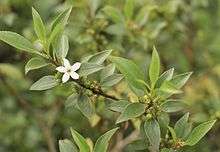Myoporum viscosum
Myoporum viscosum, commonly known as sticky boobialla, is a plant in the figwort family, Scrophulariaceae and is endemic to South Australia. It is unusual in that sometimes, especially when the leaves are crushed, it has an extremely unpleasant smell.
| Sticky boobialla | |
|---|---|
 | |
| Scientific classification | |
| Kingdom: | Plantae |
| Clade: | Tracheophytes |
| Clade: | Angiosperms |
| Clade: | Eudicots |
| Clade: | Asterids |
| Order: | Lamiales |
| Family: | Scrophulariaceae |
| Genus: | Myoporum |
| Species: | M. viscosum |
| Binomial name | |
| Myoporum viscosum R.Br.[1] | |
| Synonyms[1] | |
| |
Description
Myoporum viscosum is a shrub which sometimes grows to 2 metres (7 ft) in height with young branches that are flattened and sticky. The leaves are arranged alternately and mostly 20–52 millimetres (0.8–2 in) long, 7–20 millimetres (0.3–0.8 in) wide, thick and stiff. The base of the leaf partly wraps around the stem and the leaf blade is folded or curved with serrated edges and has many oil dots.[2][3][4]
The flowers appear in the leaf axils in clusters of 5 to 8 on a stalk 4–8 millimetres (0.2–0.3 in) long. There are 5 triangular sepals and 5 petals joined at their bases to form a bell-shaped tube. The petals are white with a slight purplish flush and purple spots. The petal tube is 3–4 millimetres (0.1–0.2 in) long, the lobes are about the same length and the inside of the tube as well as the bases of the lobes are hairy. The main flowering period is from June to November and is followed by fruits which are succulent, rounded purplish drupes around 3–5 millimetres (0.1–0.2 in) in diameter.[2][3] [4]
Taxonomy and naming
Myoporum viscosum was first formally described by botanist Robert Brown in Prodromus Florae Novae Hollandiae in 1810[1][5] from a specimen collected at Memory Cove. The specific epithet is derived from the Latin word viscum meaning "bird-lime" with the ending -osus "abounding in", that is, "sticky" or "viscid".[2][6]
Distribution and habitat
For many years this species has been confused with the much more common species Myoporum petiolatum which has thinner, noticeably petiolate and non-odorous leaves.[2] Myoporum viscosum has a restricted distribution encompassing Kangaroo Island and coastal areas of the Eyre and Yorke peninsulas.[2]
Use in horticulture
Sticky boobialla is a hardy plant which can tolerate salt spray and can be used as a low screening plant. It is readily propagated from cuttings and grows best in full sun.[7]
References
- "Myoporum viscosum". Australian Plant Name Index (APNI), IBIS database. Centre for Plant Biodiversity Research, Australian Government.
- Chinnock, R.J. (Bob) (2007). Eremophila and allied genera : a monograph of the plant family Myoporaceae (1st ed.). Dural, NSW: Rosenberg. pp. 121–123. ISBN 9781877058165.
- "Myoporum viscosum". Electronic flora of South Australia. Retrieved 3 December 2015.
- "Myoporum viscosum". Lucid central. Retrieved 3 December 2015.
- Brown, Robert (1810). Prodromus Florae Novae Hollandiae. London. p. 516. Retrieved 3 December 2015.
- Francis Aubie Sharr (2019). Western Australian Plant Names and their Meanings. Kardinya, Western Australia: Four Gables Press. p. 337. ISBN 9780958034180.
- Wrigley, John W.; Fagg, Murray (1983). Australian native plants : a manual for their propagation, cultivation and use in landscaping (2nd ed.). Sydney: Collins. p. 272. ISBN 0002165759.